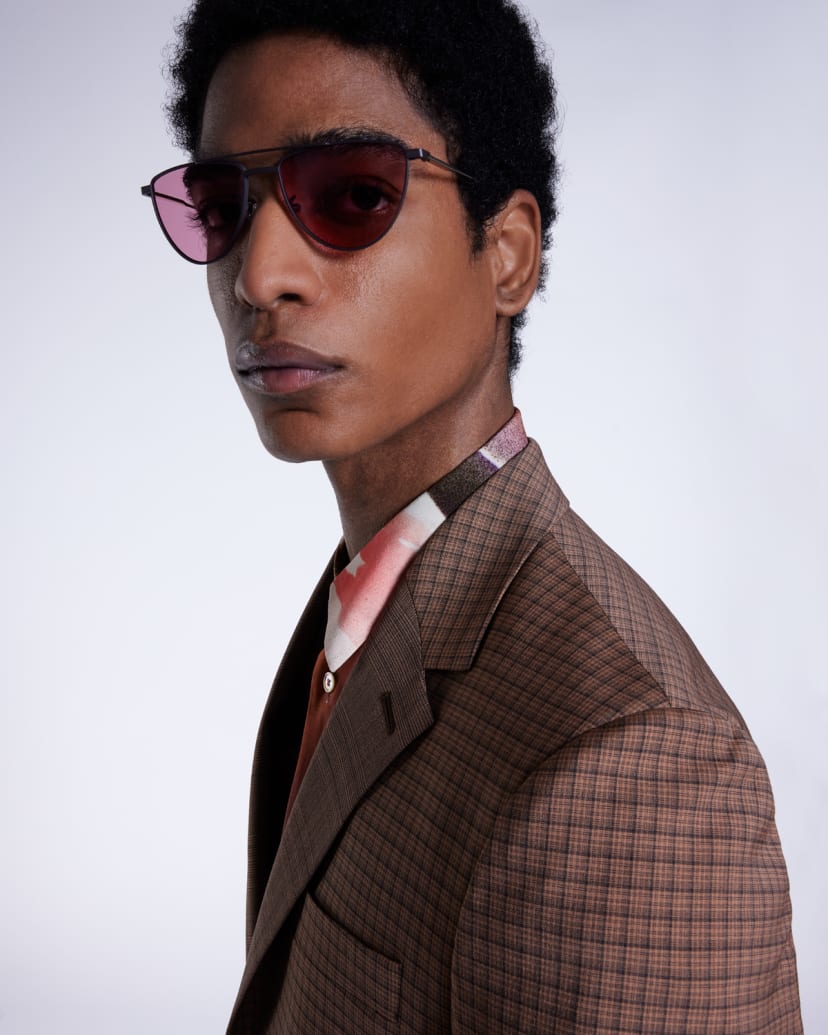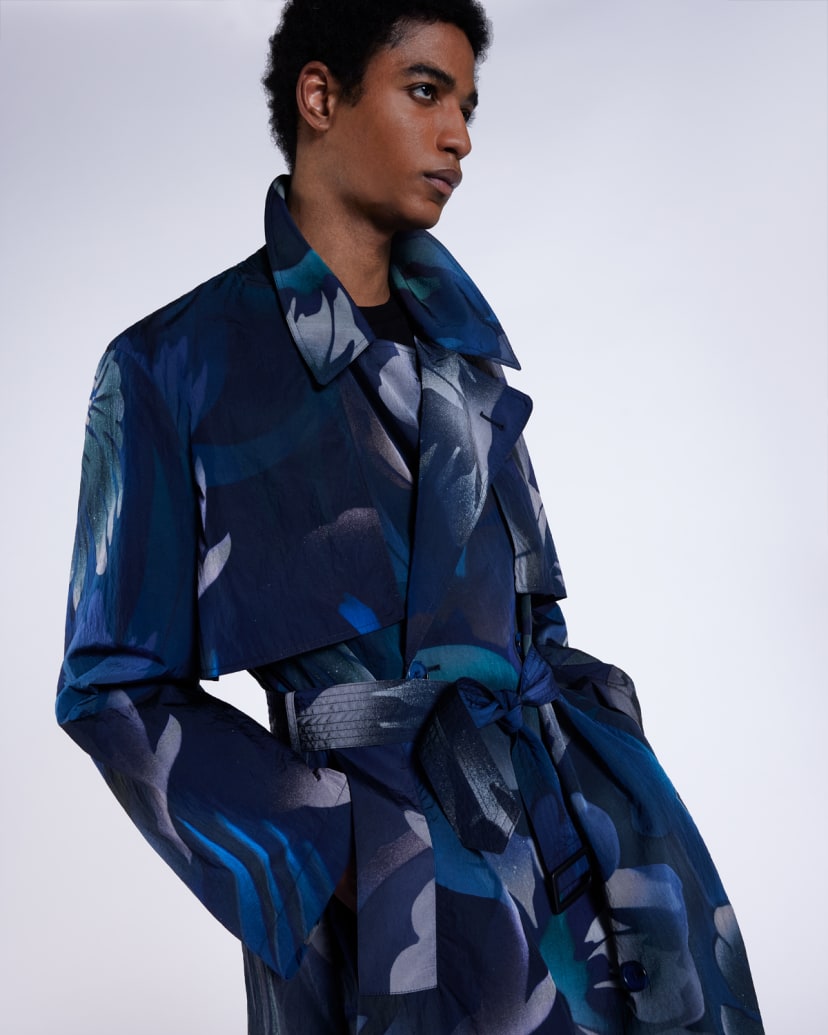
The suit – a garment that has hardly changed in the last 100 years – is often considered the most traditional and conservative item in a man’s wardrobe. But, as Paul Smith’s Five Pillars of Tailoring proves, the modern men’s suit comes in all shapes and sizes – from smart business suits to, the current topic at hand, statement suits and men’s designer suits. In fact, with dress codes relaxing more and more, choosing a suit over something more casual, could be considered a statement in and of itself. But, in general, the term is applied to unique suits, or those that are unconventional in some way: whether through pattern, colour or cut. Here’s our guide to getting it right.
What Is A Statement Suit?
There’s nothing necessarily new about statement men’s tailoring or men’s designer suits. You need only think of the stylish suits that David Bowie or Jimmy Page were wearing in the 1970s to see that suits have long had their statement counterparts. But there has been a shift of late towards more relaxed and bold suits: coloured, printed and patterned suits are all a much more common sight, as are laidback cuts and retro-inspired silhouettes. In short, these are not your typical office suits.
When Should You Wear A Statement Suit?
Along with the style of tailored suits changing, so too are the rules of when to wear them: tailoring, as it becomes more bolder and less staid, is no longer necessarily reserved for the office, special events or formal occasions. Instead, men’s statement tailoring is increasingly being seen a trend-conscious, relaxed choice for everyday and casual events – a sign perhaps that, post-pandemic, we’re collectively ready to dress up again. And so, the answer to this question is, quite simply, whenever you feel like it.
The Modern Three-Piece Suit
Often seen as a remnant of a bygone age, the three-piece suit is arguably the most traditional form of business suit. But for SS23, Paul Smith turned that on its head, introducing his thoroughly modern take on the three-piece suit. It consists of a more relaxed, workwear inspired jacket, laidback trousers or shorts, and crucially, a V-neck vest that serves as a contemporary equivalent of a waistcoat. In classic suiting fabrics as well as less traditional ones, such as gabardine – as well as a muted, pastel palette – Paul Smith’s 3-piece suit ensemble is a subversive take on one of menswear’s enduring tailoring icons.
Patterned & Printed Suits
You need only look at a selection of pictures from the latest red carpet or awards show to see that patterned and printed suits are becoming increasingly popular. This is thanks, in large part, to the return of maximalist fashion. A brief glance through the Paul Smith archive will tell you that the designer has a long history of patterned suits, having experimented with everything from floral suits and geometric suits to graphic designs. In the SS23 collection, for example, the designer’s iconic stripe is revisited in a summery pastel ombre, offering a more sophisticated take on the tie-dye trend. And while they may not necessarily be appropriate in professional settings, the trick to pulling a patterned suit off is simple: wear it with the same level of confidence as you would jeans and a T-shirt.
Checked Suits
Checked suits are often considered one of the more traditional or ‘old-fashioned’ types of tailoring – recalling the sorts of tweedy suits worn by gentlemen for countryside pursuits. Hardly the most adventurous choice, right? More and more however, designers are subverting that expectation with bolder checks and interesting cuts. Depending on what specific check you choose, the men’s checked suit can look and feel like a thoroughly modern option. Look out for oversized windowpane checked suits, colourful Prince of Wales checks and striking tartans to really make a statement.
Coloured Suits
Again, coloured suits for men are nothing new: there’s a reason, after all, that the powder blue tux was all the rage in the 1980s. Then there’s the fact that pastel-toned tailoring has long been a popular choice for wedding suits – both for guests and grooms. The difference nowadays is that there’s hardly a shade on the spectrum that you can’t get away with. Case in point: Paul Smith collections in recent years have featured everything from neon orange to cobalt blue. Ultimately, a coloured suit is a sure-fire way to inject a dash of cheer and character into your formal wardrobe.
Floral Shirts & Suits
As a designer, florals for men are one of Paul Smith’s hallmarks, and he often utilises photoprints and digital prints to create hyper-realistic bold designs that really stand out from the crowd. In tailoring, floral suits offer the juxtaposition between something stereotypically ‘masculine’ – the suit itself – and something stereotypically ‘feminine’ – the floral. Which is precisely why this 1970s-inspired trend is doing the rounds again. If you want to dabble or dip your toe, but aren’t ready to go all the way, a men’s floral shirt is the next best thing to a floral suit. Ditsy patterns – which translates to small – are the easiest way to pull this off and, if the colours are classic and muted, can even be worn with a business suit.
Textured Suits
First things first: not all textured suits fall under the banner of men’s statement suits. After all, every suit fabric has texture, whether it be a classic business-appropriate sharkskin, a summery hopsack or a houndstooth tweed. But you certainly can use texture to make a statement. Jacquard is a word to look out for if you’re looking for something more striking than most, since it often incorporates intricate pattens into the weave. But for a more everyday option, keep a corduroy suit in mind. Fine or wide-waled corduroy tailoring is not only a particularly on-trend option at the moment, it also has the built-in bonus of being extremely comfortable.
Slim vs Oversized Suits
Fit is a very particular and subjective thing, especially so when it comes to bold suits. Some men prefer more room in the shoulders; others are happier with a slimmer silhouette. But while personal preference certainly comes into it, there’s no denying that the cut of your suit has a decided effect on the impression it gives. As a rule, slimmer, trimmer suits (not to be confused with skinny suits) tend to look smarter and more traditional. Relaxed, unstructured, slouchy and oversized suits, on the other hand, are once again having a moment in the sartorial sun: with wider lapels, longer-length boxy jackets and wide-legged or even flared trousers considered de rigueur right now.
Statement Suit Trousers
Suit trousers are often an afterthought when discussing the topic of tailoring: the most common form of men’s suit trousers following the same flat fronted formula, with pleated pairs occasionally making an appearance. But there’s a key word that comes to mind when describing modern statement suit trousers for men: exaggerated. A rise in looser, more louche and wider tailored trousers for men is a nod to the 1970s (a decade that the style world is currently fixated on) and points to the easing of rules of men’s dress codes.
Statement Suit Shoes & Boots
Men’s Oxfords, brogues and Derby shoes used to be the only acceptable footwear to wear with a suit, but just as tailoring is evolving, so too are the formal shoes you wear it with. Men’s suit shoes come in all shapes and sizes these days, but one particular style seems to dominate the sartorial discussion: chunky. Whether it’s a pair of loafers, Derby shoes or boots, an oversized sole – with or without lugs – seems to be a prerequisite. Unorthodox colours, too, are increasingly common, with mauve, oxblood and grey all featuring in the latest Paul Smith collection.
A Note On Suit Linings
If you’re not quite ready to go bold head to toe – there is another way to experiment with statement suiting and tailoring. Enter: the coloured or patterned lining. A Paul Smith signature for decades, a statement lining is a subtler way to distinguish yourself from a sea of similar-looking tailored suits.
Discover More
Do you want to keep in touch?
Words: Molly Isabella Smith
Photography: Ollie Thompson
Published: 03.23
Words: Molly Isabella Smith









